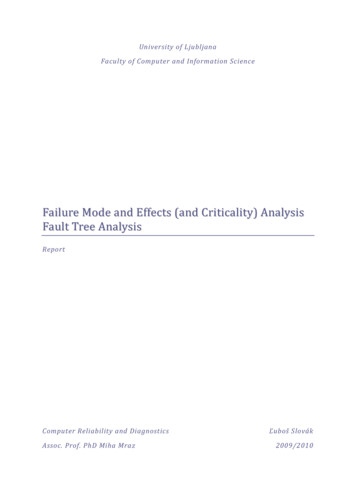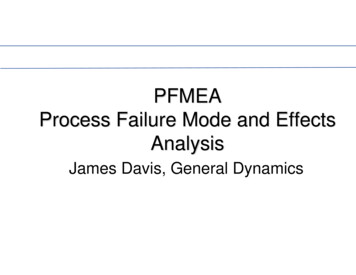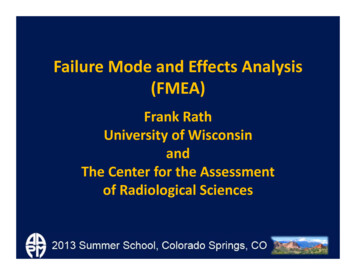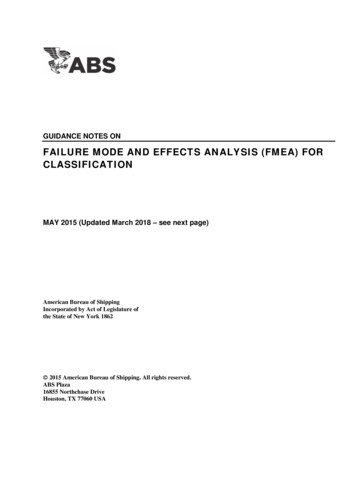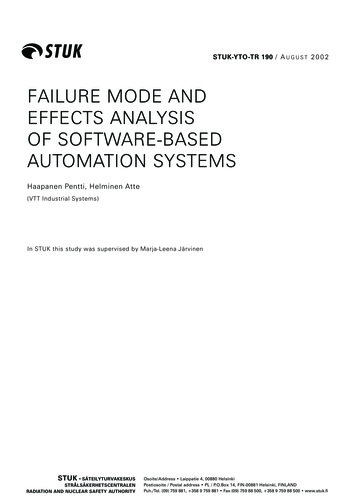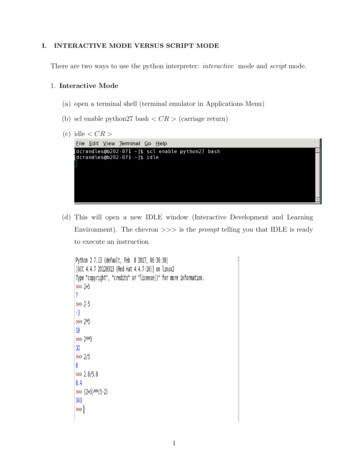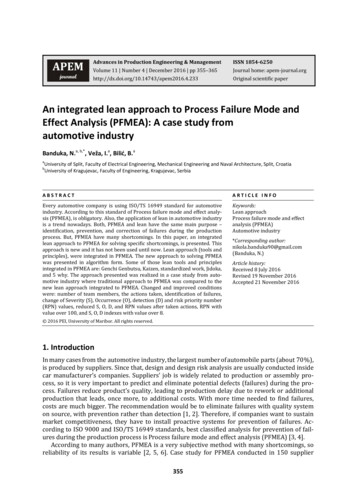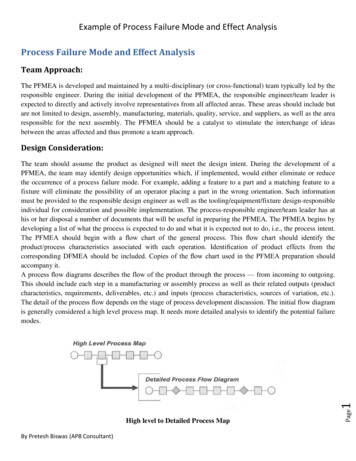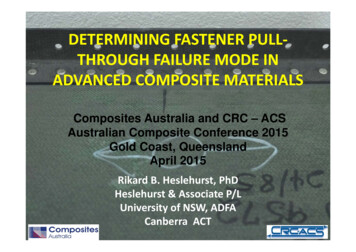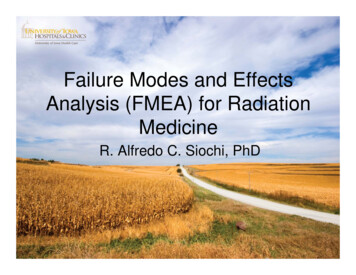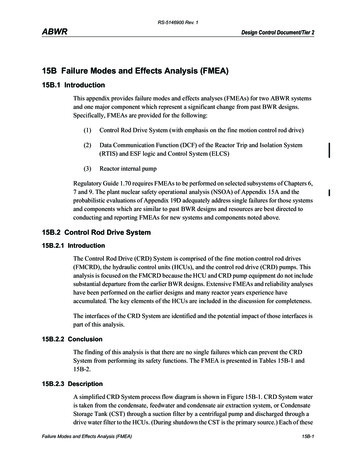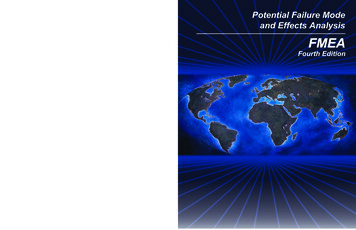
Transcription
Potential Failure Modeand Effects AnalysisPotential Failure Mode and Effects Analysis – FMEA – Fourth EditionFourth EditionFMEA
POTENTIALFAILURE MODE ANDEFFECTS ANALYSIS(FMEA)Reference ManualFourth EditionFirst Edition, February 1993 Second Edition, February 1995 Third Edition, July 2001,Fourth Edition, June 2008Copyright 1993, 1995, 2001, 2008Chrysler LLC, Ford Motor Company, General Motors CorporationISBN: 978-1-60534-136-1
FOREWORD4th EditionThe FMEA 4th Edition is a reference manual to be used by suppliers to Chrysler LLC, Ford MotorCompany, and General Motors Corporation as a guide to assist them in the development of bothDesign and Process FMEAs. The manual does not define requirements; it is intended to clarifyquestions concerning the technical development of FMEAs. This manual is aligned with SAEJ1739.Summary of Changes in the 4th edition FMEA Reference ManualThe DFMEA and PFMEA methods described in the 4th edition FMEA Reference Manual includethose associated with design at the system, subsystem, interface, and component level and theprocess at manufacturing and assembly operations.General Changes The formatting used in the 4th edition is intended to provide easier reading.o An index is included.o Icons are used to indicate key paragraphs and visual cues are used.Additional examples and verbiage have been provided to improve the utility of themanual and to provide a closer tie into the FMEA process as it develops.Reinforcement of the need for management support, interest, and review of theFMEA process and results.Define and strengthen the understanding of the linkage between DFMEA andPFMEA as well as defining the linkages to other tools.Improvements to the Severity, Occurrence, Detection ranking tables so that they aremore meaningful to real world analysis and usage.Alternative methods are introduced that are currently being applied in industry.o Additional appendices which have example forms and special case application ofFMEA.o The focus on the “standard form” has been replaced with several options thatrepresent the current application of FMEA in industry.The suggestion that RPN not be used as the primary means for assessing risk. Theneed for improvement has been revised including an additional method, and the useof thresholds on RPN is clarified as a practice that is not recommended.Chapter I provides general FMEA guidelines, the need for management support and having adefined process for developing and maintaining FMEAs, and the need for continuousimprovement.Chapter II describes the general application of the FMEA methodology, which is commonbetween DFMEA and PFMEA processes. This includes the planning, strategy, action plans, andthe need for management support and responsibility in FMEAs.Chapter III focuses on DFMEA (Design Failure Mode Effects and Analysis), establishing thescope of the analysis, use of block diagrams, various types of DFMEAs, formation of the teams,basic procedure for analysis, action plans, and follow-up, alternatives to RPN, and connection toPFMEAs and validation plans.i
Chapter IV focuses on PFMEA (Process Failure Mode Effects and Analysis), establishing thescope of the analysis, use of flow diagrams, formation of teams, basic procedure for analysis,action plans, the connection to DFMEAs and the development of control plans.The Appendices have several examples of forms for DMFEA and PFMEA and addressesdifferent applications and procedures for addressing design and process risk.The Supplier Quality Requirements Task Force would like to thank the following individuals, andtheir companies, who have contributed their time and efforts to the development of this edition ofthe FMEA Reference Manual:Michael Down, General Motors CorporationLawrence Brozowski, General Motors CorporationHisham Younis, Ford Motor CompanyDavid Benedict, Chrysler LLCJohn Feghali, Chrysler LLCMichael Schubert, DelphiRhonda Brender, DelphiGregory Gruska, OmnexGlen Vallance, Control Planning InitiativesMilena Krasich, BoseWilliam Haughey, ReliaTrainThis manual is a copyright of Chrysler LLC, Ford Motor Company and General MotorsCorporation, with all rights reserved. Additional copies may be obtained from AIAG @www.aiag.org. Supply chain organizations of Chrysler LLC, Ford Motor Company or GeneralMotors Corporation have permission to copy forms used in this manual.ii
TABLE OF CONTENTSGeneral Changes. iChapter I. 1General FMEA Guidelines . 1Introduction . 2FMEA Process. 2Purpose of Manual. 3Scope of Manual. 4Impact on Organization and Management. 4FMEA Explained. 5Follow-up and Continuous Improvement . 6Chapter II. 7Overview of FMEA Strategy, Planning and Implementation. 7Introduction . 8Basic Structure . 8Approach . 8Identify the Team . 9Define the Scope. 10Define the Customer. 11Indentify Functions, Requirements, and Specifications . 11Identify Potential Failure Modes . 12Identify Potential Effects . 12Identify Potential Causes . 12Identify Controls. 13Identifying and Assessing Risk . 13Recommended Actions and Results . 13Management Responsibility . 14Chapter III . 15DFMEA Design Failure Mode and Effects Analysis . 15Introduction . 16Customer Defined. 16Team Approach . 17Manufacturing, Assembly and Serviceability Considerations. 17Development of a Design FMEA . 18Prerequisites . 18Block (Boundary) Diagrams. 18Parameter (P) Diagrams. 21Functional Requirements. 22Other Tools and Information Resources. 22Example DFMEA. 25Header of the Design FMEA Form (fields A-H) . 25Body of the DFMEA Form (fields a – n). 29Maintaining DFMEAs . 64Leveraging DFMEAs . 65Linkages . 65Design Verification Plan & Report (DVP&R) . 66PFMEA. 66Chapter IV . 67PFMEA Process Failure Mode and Effects Analysis . 67Introduction . 68Customer Defined. 69Team Approach . 69Design Considerations. 69Development of a Process FMEA . 70iii
Prerequisites . 70Process Flow Diagram and linkage to PFMEA . 70Other Tools and Information Sources. 73Research Information . 73Example PFMEA Form. 75Header of the Process FMEA Form (fields A-H) . 75Body of the PFMEA Form (fields a – n) . 77Maintaining PFMEAs. 110Leveraging PFMEAs . 110Linkages . 111To DFMEA. 111To Control Plan . 112APPENDICES. 113Appendix A: Sample Forms .
As a tool in risk evaluation, FMEA is considered to be a method to identify severity of potential effects of failure and to provide an input to mitigating measures to reduce risk. In many applications, FMEA also includes an estimation of the probability of occurrence of the causes of failure and their resultant failure modes. This broadens the analysis by providing
